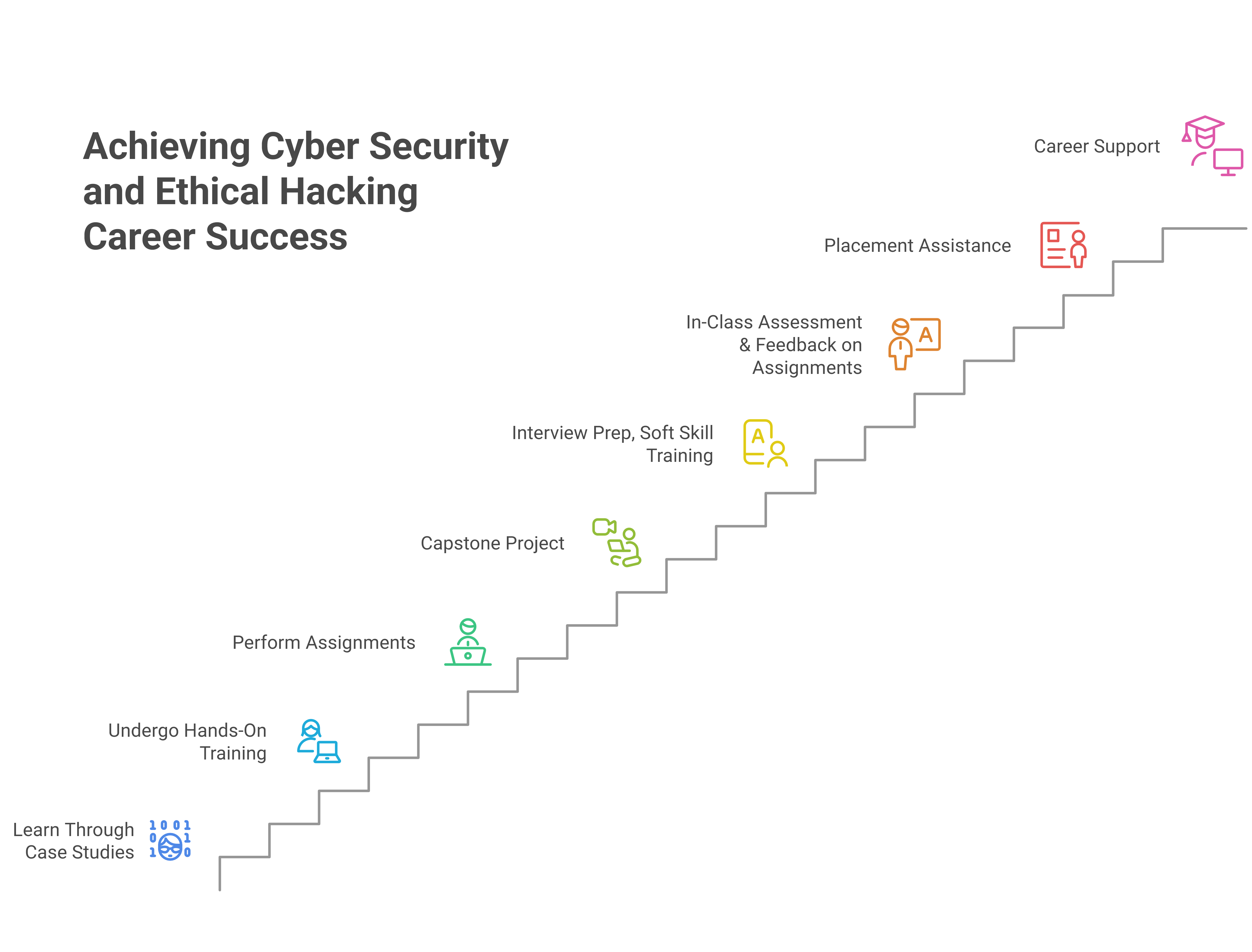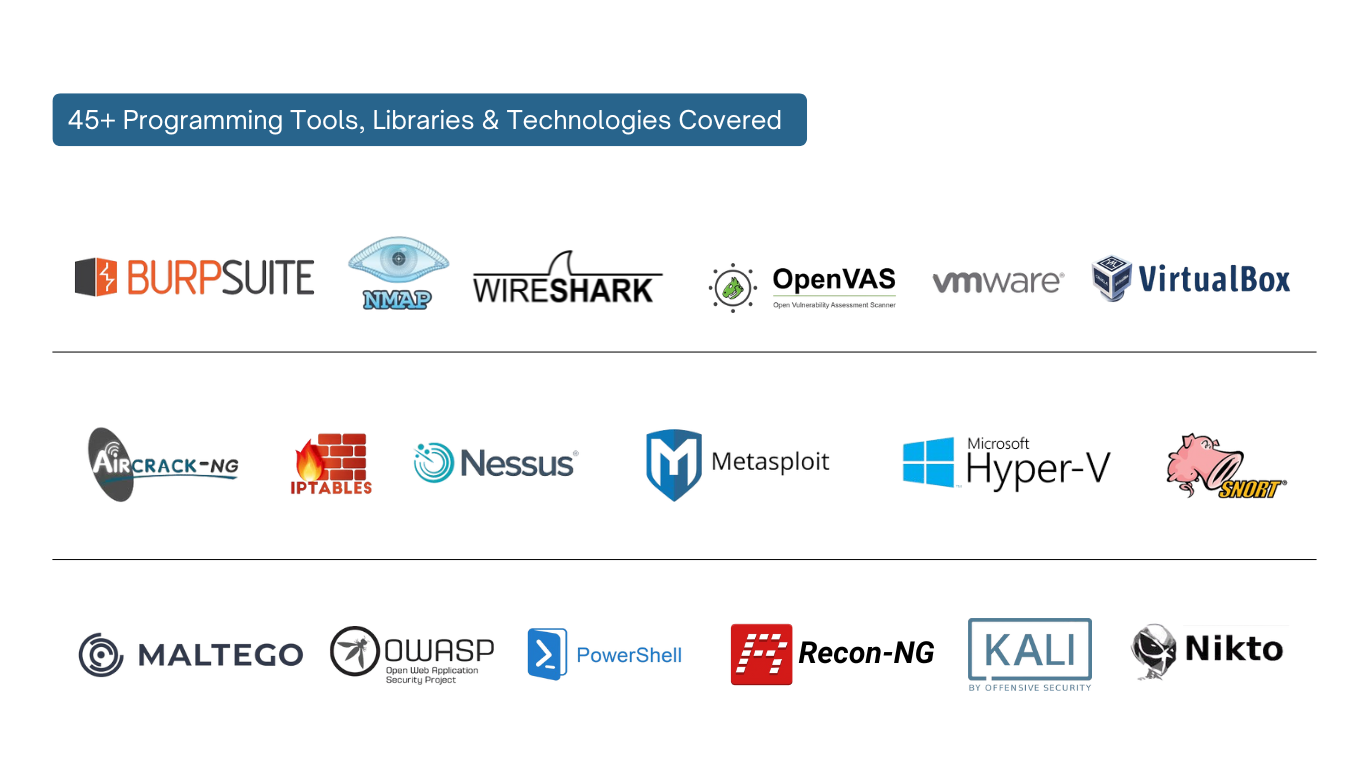Diploma in Cyber Security & Ethical Hacking
Unlimited Placement Calls
Salary Range: 2.5 LPA to 3.5 LPA
Why Learning Ethical Hacking Will Secure Your Future!
According to reports, the global cybersecurity market is expected to grow at a CAGR of 11.0% from 2022 to 2030, reaching a market size of USD 403.4 billion by 2030. This growth is driven by increasing cyber threats, data breaches, and the need for robust security measures across industries.
About This Program
After extensive research and consultations with industry experts, we have designed a Diploma in Cyber Security & Ethical Hacking (DCSEH) program, tailored for job seekers and professionals aiming to build a career in the rapidly growing cybersecurity field. This comprehensive program blends live lectures with online sessions to equip you with essential skills in ethical hacking, network security, penetration testing, cyber risk management, and more. Through hands-on training, you will gain a deep understanding of various attack vectors, countermeasures, and industry-standard tools used to protect organizations from cyber threats. The program also incorporates a capstone project, giving you practical exposure to real-world security challenges and solutions.
Additionally, we focus on soft skills development through our Employability Development Program, ensuring you are well-prepared for the job market. Our Diploma in Cyber Security & Ethical Hacking (DCSEH) is a unique program that includes expert-led sessions on ethical hacking techniques, network security protocols, and cyber defense mechanisms. With 100% placement support and rigorous placement drives within our 500+ client base, we aim to open doors to multiple job opportunities in this high-demand field. Cybersecurity is one of the fastest-growing industries globally, with the demand for skilled professionals continuing to surge.
Various sectors have ramped up their cybersecurity efforts, creating more job opportunities for professionals in this domain, including:
- BFSI (Banking, Financial Services, and Insurance)
- Telecommunication
- IT & ITES (Information Technology and IT-Enabled Services)
- Government & Public Sector
- Retail & E-commerce
- Healthcare & Life Sciences
- Energy & Utilities
- Media & Entertainment
Eligibility:
- Any undergraduate or graduate with basic computer knowledge can apply; a background in Computer Science or IT is beneficial but not required.
- Working professionals aspiring to do career into Cyber Security field.
Highlights:

- Specialized Diploma designed by Industry Experts
- Exposure to Hands-on Labs during the training
- Trainers with Extensive Industry Experience
- Real-World Simulation Labs
- 45+ Programming Tools, Libraries & Technologies Covered
- Employability Enhancement Program (Soft Skills)
- Duration of 3 Months: Weekdays & Weekend Batches
- Industry Exposure : Capstone Projects
- Starting Salary Range: 2.5 LPA to 3.5 LPA
- 100% Job Assistance (Unlimited Placement Calls)
Learning Path:

Course Content:
Introduction to Networking
- What is networking?
- How the Internet Operates
- Types of Networks (LAN, WAN, VLAN, etc.) OSI Model & TCP/IP Stack
- IP Addressing (IPv4/IPv6), Subnetting, and CIDR
Network Devices and Protocols
- Switches, Routers, Firewalls
- Common Protocols: HTTP, HTTPS, DNS, DHCP, FTP, SMTP VPN, NAT, ARP, IPSEC
- Packet Analysis Basics (Wireshark, tcpdump)
Network Troubleshooting and Tools
- Firewall, IDS/IPS Overview
- VLAN, VPN, NAT
- Ping, Traceroute, ARP, and NSLookup
- Common Network Vulnerabilities
Windows Administration Basics
- Windows Architecture / File System/ File Permissions
- Practical: SAM Files & System Files
- Password Hashing (LM, NTLM, Kerberos)
- Filesystem and Registry Structure
- User and Group Management
Windows Networking and Security
- Active Directory
- Lightweight Directory Access Protocol (LDAP)
- Task Scheduling
- Windows Event Logs
- Windows Networking Features (SMB, RDP, PowerShell Remoting)
Linux Fundamentals & Lab Setup
- Introduction to Linux
- Linux Architecture and Distributions
- Installing VirtualBox & Kali
- Shell and File System Basics
- User and Group Management
- File Permissions and Ownership (chmod)
- Linux Command (ifconfig, ip, netstat, etc.)
- Monitoring and Logs (top, ps, dmesg, syslog)
Introduction to Information Security and Ethical Hacking
- Types of Hackers
- CIA Triad
- Key Concepts and Terminologies (CVE, CVSS, TTPs)
- Cyber Kill Chain Methodology
- MITRE ATT&CK Framework
- Risk Management
- Verticals of security team in Industry
- Information Security Laws and Standards
- Cyber Law in different Countries
Footprinting and Reconnaissance
- What is Digital Footprinting
- Types of Information Gathered (Active/Passive)
- Social Engineering, Email Footprinting, and Website Footprinting (Dorking, Maltego, Spiderfoot, Shodan)
- Countermeasures
- Anonymization Tools
Network Exploration
- Overview of Network Scanning
- Types of Scans: TCP, SYN, ACK, and UDP Packet Crafting (Hping3, Scapy)
- Scanning (NMAP, Netcat, IKE Scan)
- Enumeration Techniques & Introduction to Metasploit
- NetBIOS Enumeration
- Enumerating SNMP using SnmpWalk and Nmap
- DOS Attacks (Syn flood, smurf attack, Ping of death)
Vulnerability Management
- Vulnerability Assessment Techniques
- Automated vs. Manual Assessment
- Types of Vulnerabilities: Network, System, and Application
- Tools for Vulnerability Analysis
- Nessus, OpenVAS, and Qualys (Practical)
- Interpreting Vulnerability Reports
- Prioritizing Vulnerabilities
- Remediation Strategies
Password Hacking
- Types & Techniques of Password Cracking
- Cracking Passwords (Bruteforce, SSH)
- Privilege Escalation & How to Defend Against Privilege Escalation
- Maintaining Access (RCE, Persistence) & Covering Tracks
Network Sniffing
- Network Sniffing Techniques
- Protocols Susceptible to Sniffing
- MAC Spoofing, ARP Poisoning
- DHCP & Starvation Attacks
- Countermeasures
Malware Analysis
- Types of Malware (Trojan, Fileless, Worms)
- Malware Analysis (Static/Dynamic) with tools
Wireless Network Hacking
- IEEE 802.11, Type of wireless networks
- Wireless Encryption Techniques
- Wireless Discovery with Tools
- Cracking WPA/WPA2
- MITM, Deauth Attack
- Evil Twin Attack
Introduction to Web App Pentesting
- How Website Works & Headers
- Introduction to Burp Suite
- Web Server (Apache, IIS, Nginx) & Operations
- OWASP Top 10
- Evade Detection (Honeypots)
Web App Pentesting
- What is Same Origin
- CORS Vulnerability
- Session Hijacking / JWT Hijacking
- Password Attacks: Brute-forcing
- XSS/HTML Injection Attack (DOM, Reflected)
- Countermeasures
Web App Pentesting 2
- OTP Bypass
- CSRF vs SSRF
- Clickjacking
- Parameter Tampering
- Countermeasures
Web App Penetration 3
- File Upload Vulnerability
- SQL Injection & Types
- Buffer Overflow
- Countermeasures
Introduction To Mobile Architecture
- OWASP Top 10
- Introduction to IOS & Android Architecture
- Rooting Android (ABD)
Mobile Application Pentesting
- Andro Rat
- Android Pentesting & Tools
- MDM & Mobile Security Guidelines
Cloud Security
- Cloud Computing Concepts
- Types of Cloud Services (IaaS, PaaS, SaaS)
- Cloud Deployment Models (Public, Private, Hybrid) (Practical)
- Cloud Security Challenges
- Data Breaches, Account Hijacking, and Insider Threats
- Cloud Security Tools
- CASBs, Cloud Encryption, and IAM Solutions
Incident Response and Handling
- Incident Response Methodology
- Preparation, Identification, Containment, Eradication, Recovery, and Lessons Learned
- Steps in Incident Handling
- Detection, Analysis, and Documentation Tools for Incident Response
- SIEMs, Forensic Tools, and Threat Intelligence Platforms (Practical)
Cryptography
- Cryptography Concepts and Encryption Algorithms
- Countermeasures
Interview Preparation
- Preparing for an Interview
- Interview Question Discussion
Analysing and Solving Vulnerable Machines: 1
- Reconnaissance (Information Gathering)
- Vulnerability Scanning
- Exploitation
- Privilege Escalation
- Post-Exploitation
Analysing and Solving Vulnerable Machines: 2
- Documentation
- Analysis
- Mitigation
- Reporting
- Cleanup and Restoration
Tools and Technologies:

Job Roles:
By completing this course, you will be equipped to take on roles such as:
- Ethical Hacker (Penetration Tester)
- Cyber Security Analyst
- Information Security Consultant
- Network Security Engineer
- Vulnerability Assessment Specialist
- Security Operations Centre (SOC) Analyst
- Penetration Testing Specialist
- Malware Analyst
- Incident Response Specialist
- Cloud Security Engineer
- Web Application Security Specialist
- Mobile Security Expert
- Security Auditor
- Security Researcher
Duration
03 Months
This Course Include
- 45+ Programming Tools, Libraries & Technologies Covered
- Real-World Simulation Labs
- 100% Job Assistance (Unlimited Placement Calls)
- Industry Exposure : Capstone Projects
Enquire Now
Industry Collaboration & Placements
+91 - 83297 03277
enquiry@nextgenedu.in






